Installed Products -
ReaderRouters and ReaderHubs
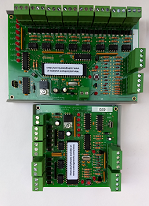
Managing shared card readers
The ReaderRouter and ReaderHub products are designed to improve and simplify connection with card readers that are shared by more than one controller. They are ideal for multi-tenant facilities which have common points of access such as perimeter doors, elevators and common spaces.
The ReaderRouter isolates and sends card swipe data only to those controllers that you have selected to get the data, based on rules that you select. The ReaderHub sends the data to all connected controllers, providing electrical isolation between the controllers and also providing signal conditioning. Both products are available in 4- and 8-port versions.
Product Update - The latest version of the ReaderRouter™ product line (starting with firmware version 1.06) features some new capabilities. They include: USB communications port – Users can now connect directly from a Windows PC to the ReaderRouter using a USB-A male to USB-Micro B male cable. The ReaderRouter has USB port-powered programming. An external DC power supply is no longer needed for programming. Note: the USB port power is not recommended for installed operation. Improved Wiegand data noise rejection. Card swipes of less than 3 bits are ignored. Improved processing of capacitively coupled Wiegand lines. New input LED diagnostic blink codes for:
Normal Swipe
A missing Ones or Zeros line
Shorted or capacitively coupled lines
These LED blink codes support quicker troubleshooting of common install problems and noisy environments (like elevator installations).
ReaderRouter™ 4-Port and 8-Port
The ReaderRouter™ simplifies the routing of card swipes to multiple points within a facility. The ReaderRouter re-directs Wiegand card swipes from a reader to any output based on a routing definition that you create. An easy to use configuration tool allows you to define routing rules and card formats that can be quickly downloaded into the ReaderRouter.
Customers can create recurring revenue
Building owners can charge tenants one-time or monthly fees for access to the perimeter door
readers. This can pay for the ReaderRouter™ in a short time and even create revenue for the owner!
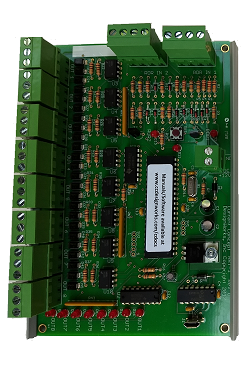
How it works
The ReaderRouter’s selective routing capability allows partitioning of reader data
to multiple client systems. A typical application for the ReaderRouter is a lobby/perimeter
reader in a shared corporate office building, allowing each client to maintain control
of their own access and badging policies. Other applications would be similar for parking lots
and other common access areas. It’s an easy way to partition the use of any doors in a facility.
The ReaderRouter™ allows you to connect up to eight different access systems to a single reader. (on 8-port version)
Card swipes of up to 64 bits are supported. Any combination of bits (up to 32 bits) can be used to direct the swipe, including fields such as:
- card number
- facility code
- card format
- custom-defined fields
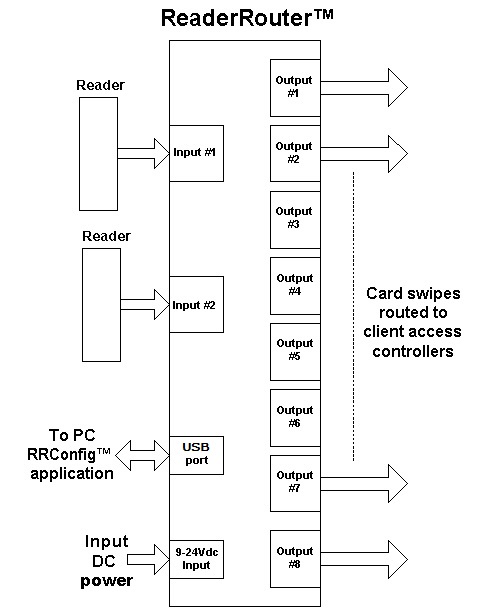
Easy configuration
Using the simple RRConfig application, the user can configure the routing based on a range
of numbers.
The user can configure:
- The card formats used in your system
- 8 different format definitions
- card format
- custom-defined fields
- Card numbers to be sent to an output port
- Output ports to send all swipe activity
- Output ports to send undefined swipe activity
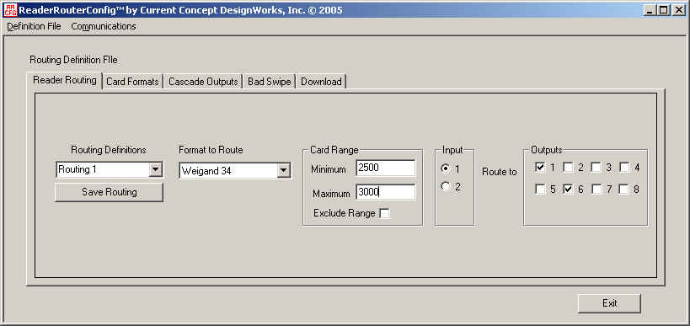
ReaderRouter Specifications:
- 2 Wiegand reader input ports (transient protected)
- 8 Wiegand reader output ports (transient protected, opto-isolated)
[4 Wiegand outputs on the 4-port version] - 1 USB port for configuration download and product updates
- Works with card formats up to 64 bits (w/ no leading or trailing characters)
- Each input port will be configured to decode and identify up to 32 bits of a card swipe for comparison. The unit will then route the entire card swipe based on pass/fail of this comparison.
- Using the RRConfig™, a routing definition is configured and downloaded to the unit, via USB port, to provide card format and routing data. Any card swipe can be routed to one or more output ports.
- LED indicators show swipe activity on all ports.
- Input power 9-12VDC at 100 mA.
- Card swipes not identified in the routing definition can be routed out any output port for observation.
- Cascade configuration setting to pass all swipes to an output port for scaling to larger setups.
- Flash programmable for field upgrades.
- Unit supplied with SnapTrack™ mounting and pluggable terminal blocks for easy installation.
- Small 4” x 6” footprint.
ReaderRouter Product Brief (PDF)
ReaderHub™ 4-Port and 8-Port
The ReaderHub functions similar to the ReaderRouter, in that it will re-transmit Wiegand card swipe data from from the reader to multiple controllers. Unlike the ReaderRouter, the ReaderHub has only two possible routing arrangements. In one mode, the ReaderHub will re-transmit any card swipe data on either input to ALL outputs. In the other mode, the ReaderHub re-transmits card swipe data on INPUT-1 to the first four outputs (or first two on the 4-port version). Card swipe data on INPUT-2 is re-transmitted to the last four outputs (or last two on the 4-port version).
Since there's no programming to do on the ReaderHub, it provides a simpler installation for those applications where configurable routing isn't needed.
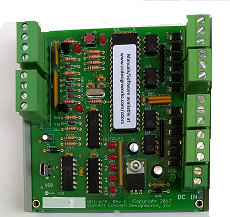
ReaderHub Specifications:
- 2 Wiegand reader input ports (transient protected)
- 8 Wiegand reader output ports (transient protected, opto-isolated)
[4 Wiegand outputs on the 4-port version] - Works with card formats up to 64 bits (w/ no leading or trailing characters)
- LED indicators show swipe activity on all ports.
- Input power 9-12VDC at 100 mA.
- These units can be cascaded with other ReaderHubs or ReaderRouters for scaling to larger setups.
- Unit supplied with SnapTrack™ mounting and pluggable terminal blocks for easy installation.
- Small 4” x 6” footprint.